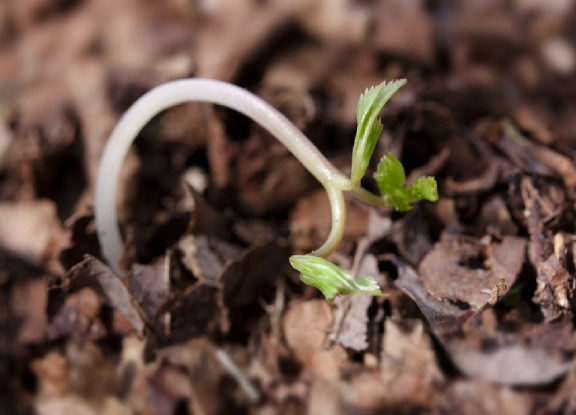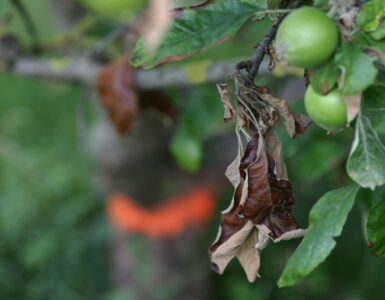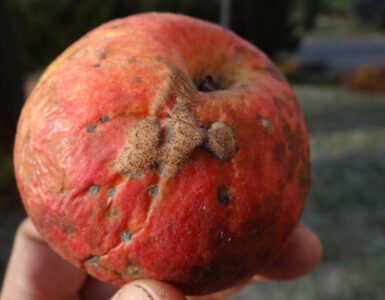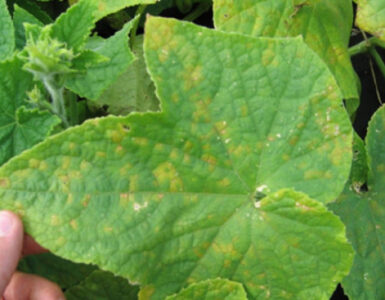Have you ever seen your healthy seedlings wilt and fall over? If so, you may have faced damping off.
It’s one of the most frustrating problems for gardeners because it attacks healthy-looking seedlings without warning.
The good news? There are several natural and effective ways to prevent and control damping-off.
Identification
Damping off is a common disease that attacks young seedlings, usually right after germination.
The stems may become thin and water-soaked near the soil line. The leaves might also look pale or wilted before the plant falls over completely.
However, damping off can also happen before germination (pre-emergence). The seedlings die before they emerge from the soil.
This disease is caused by several soil-borne fungi and water molds [1]. Cold temperatures, high humidity, and overcrowding only make the problem worse.
Once damping off takes hold, it spreads quickly from one seedling to another. It often kills a large section or an entire tray of young plants [2].
Damping off can affect almost any type of plant seedling. It’s particularly common among vegetables like tomatoes, peppers, lettuce, beans, peas, and cabbage.
Flower seedlings such as zinnias, petunias, and marigolds can also fall victim to this disease. Even plants like cannabis and corn can suffer from damping-off.
Once a plant is more mature, however, it usually becomes less vulnerable.
How to Prevent and Control Damping-Off Naturally
You can take action to prevent damping off from happening or spreading. Below are some home remedies and natural products that you can try.
1. Hydrogen Peroxide
Hydrogen peroxide is one of the simplest natural remedies for damping off. It works by killing fungal spores and disinfecting the soil.
The good thing about this solution is that it does not harm the seedlings when used correctly.
Mix one tablespoon of 3% hydrogen peroxide with two cups of water and use it to water the soil lightly before planting.
You can also use this mixture to water your young plants. It helps keep the soil surface clean and oxygen-rich.
2. Sanitize All Seed Trays and Tools
Because damping off pathogens often linger on equipment. Therefore, sanitizing seed trays, pots, and tools before planting is essential.
Wash everything with hot, soapy water, then soak for about 20 minutes in a 10% bleach solution. You can also disinfect with a solution of equal parts vinegar and water.
Never reuse potting soil that has previously hosted infected seedlings.
3. Crop Rotation
Crop rotation is another effective way to manage damping-off. Fungi and water molds can survive in the soil from one season to the next, waiting for the same type of crop to return.
Therefore, by rotating your crops, you can reduce the buildup of harmful pathogens in the soil.
For example, if damping off affected your tomato seedlings one year, try planting beans or lettuce in that area next.
4. Beneficial Microorganisms
Introducing beneficial microorganisms into your soil can help outcompete the fungi that cause damping-off. Products containing Trichoderma or Bacillus subtilis are especially effective.
You can also add compost or worm castings to your seed-starting mix. This helps to encourage beneficial microorganisms naturally.
5. Do Not Overwater
Overwatering is one of the primary triggers of damping off. Seedlings need moisture to germinate, but their soil should never stay soggy.
Therefore, allow the top layer of soil to dry slightly between waterings. Also, make sure your containers have drainage holes.
6. Neem Oil
Neem oil is a natural fungicide and insect repellent that can help prevent damping-off. It is seen as a potential treatment for controlling tomato damping-off [3].
It disrupts the life cycle of the pathogens, preventing them from spreading.
To make a homemade damping-off spray, mix two tablespoons of neem oil with a gallon of water. Also, add two teaspoons of dish soap to the mixture.
Shake well, then spray the soil and seedlings lightly.
7. Do Not Overcrowd Plants
Crowded seedlings trap moisture and limit airflow, creating ideal conditions for damping off.
Therefore, always thin out your seedlings. This way, each one has enough space to grow and airflow around it.
8. Cinnamon
Cinnamon is a natural antifungal agent. It helps inhibit fungal growth.
Therefore, sprinkle a thin layer of ground cinnamon over the soil surface right after planting your seeds.
9. Chamomile Tea
Chamomile tea is another gentle antifungal that works well against damping-off.
Brew a cup of tea, let it cool, and use it to water your seedlings or mist the soil.
To do so, place one chamomile tea bag in four cups of hot water. Let it sit overnight.
Use this DIY solution to mist your seedlings.
10. Baking Soda
Baking soda also has natural antifungal properties that can help keep damping-off at bay.
Mix one teaspoon of baking soda with a quart of water and a few drops of liquid soap. Spray the mixture on the soil surface or around the base of the seedlings.
11. Garlic Tea
You can also try garlic tea.
Just blend two bulbs of garlic in a cup of water. Afterward, mix the concentrated garlic water with a gallon of water.
Use it as a soil drench. This remedy can help stop damping off from taking hold.
12. Actinovate AG Biofungicide
Actinovate AG is an organic biofungicide. It uses a helpful microbe to combat damping off and other soil-borne diseases.
Prepare it according to the package instructions and apply it to the soil before the disease takes hold. However, it also works in the early stages of disease development.
13. Serenade ASO Biofungicide
Serenade ASO is another organic treatment that is effective against soil and foliar fungal diseases.
It is one of the best fungicides used in organic agriculture. Apply it according to the package instructions.
Takeaway
Damping off can destroy your seedlings in a matter of days. However, with a bit of prevention and care, you can stop it before it starts.
Keep your soil clean, manage moisture wisely, encourage air circulation, and make use of natural antifungal agents.








Add comment